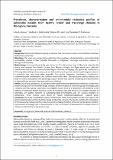| dc.description.abstract | Background: Salmonella enterica is a group of bacteria that cause enteric and systemic infection in animals
and humans worldwide.
Objectives: The study was conducted to determine the prevalence, characterization, and antimicrobial
susceptibility profiles of Non-Typhoidal Salmonella in indigenous free-range and broiler chickens in
Morogoro Municipality.
Methodology: A cross-sectional study was conducted from November 2019 to May 2020 whereby 384
cloaca swab samples from health chickens from Magadu, Mzinga, and Bigwa wards were collected.
Identification was done by standard bacteriological methods, serotyping, and genetically confirmed by
PCR using Salmonella specific primers pair and Salmonella enterica primer pair (invA and iroB gene primers).
A sensitivity test was done using Ampicillin, Tetracycline, Imipenem, Gentamycin, Ciprofloxacin,
Sulfamethoxazole trimethoprim, and Cefaclor antimicrobial discs. The descriptive statistic method was
used for analysis and paired t-test assuming unequal variance was used for comparing overall prevalence
of Salmonella spp between free range and broiler chickens.
Results: Out of 384 samples, 11 (2.9%) samples were confirmed to be Salmonella of which 8(4%) were from
broilers and 3(1.6%) were from free range chickens. Of the 11 isolates, 8 were from group B serotypes and
3 isolates were from group D serotypes. Susceptibility results showed a variable level of sensitivity to the
majority of antibiotics tested; however, levels of resistance were also found in 7/11 isolates resistant to
Ampicillin, 4/11 isolates resistant to sulfamethoxazole-trimethoprim, and 3/11 isolates resistant to
tetracycline. Three isolates were found to harbor Sulfamethoxazole(sulII) resistant gene.
Conclusion: This study revealed the presence of Salmonella carrier among chickens kept in Morogoro with
antimicrobial resistances from both free range and broilers chickens. The results underline the importance
of the biosecurity measures in the production and processing of chicken for human consumption, similarly,
improvement of management is recommende | en_US |

